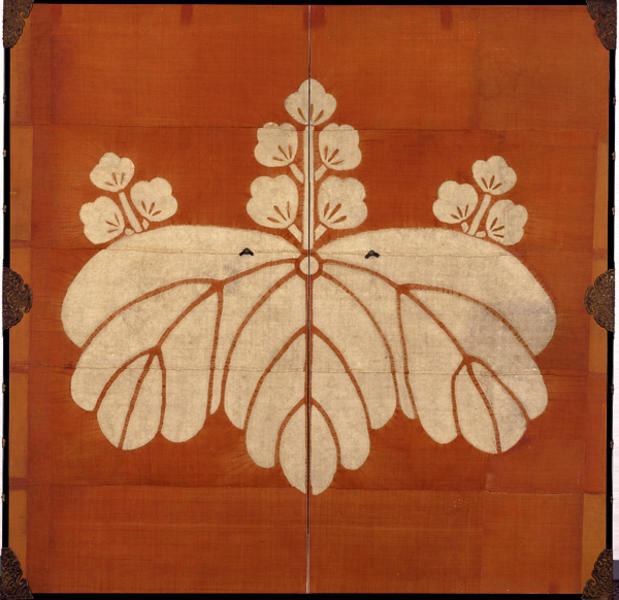Paulownia Crest Curtain Screen
- Momoyama period
- 16th century
- 2-panel screen, shibori resist-dye on silk
- H-182 W-185
- Formerly in the collection of the Nagao Museum
Catalogue Entry
Momoyama period, 16th century
2-panel screen, shibori resist dye on silk
Height, 182.0cm; width, 185.0cm
A fragment of a curtain for outdoor use with a shibori tie-dyed pattern of paulownia crest has been mounted as a 2-panel screen. The red of the plain-weave silk was probably achieved with red-madder (Rubia cordifolia) dye, and one large paulownia crest has been created in resist as a white form on the red ground. 5 lengths of approximately 40cm-wide pongee-like plain silk have been stacked horizontally and joined along their selvages by silk stitching to create a 5 panel curtain (the joining threads are a later addition). The paulownia crest is 153cm wide and some 129cm tall, stretching from the top rank of fabric to the 5th. The crest was created through the stitched shibori method, and traces of the binding linen threads remain in some of the shibori knot areas. The needle holes for the shibori knotting are relatively small. 2 small indigo decorative knots have been stitched in the center of the paulownia crest, placed on the seam between the 2nd and 3rd panels. These are traces of "peep-holes" that would have been opened as wind breaks along a section of the seams, and at present these holes have been stitched shut. Traces of small attachments placed at 40cm intervals can be found along the top edge of the top panel of silk.
Such curtains for outdoor use were produced from Japan's medieval period through its pre-modern period, and specific customs developed about the measurements, construction method, number and size of family crests displayed, and other elements of these curtains. This fragment of a curtain had already been detached from its original format, and hence the overall structure of the curtain cannot be determined, but it was likely that this was a 5-width curtain at the very least, over 2 jo 5 shaku in width (approximately 760cm).
According to the traditions associated with this work, this curtain was used by Toyotomi Hideyoshi at his famous Daigo flower-viewing party. The 5 or 7 paulownia crests that would have magnificently adorned the 5-width curtain, as seen in Ise Sadatake's Gunyoi (Horeki 11, 1761) description of the width and breadth of the great leader's curtain, would have been appropriate for use by Hideyoshi.
Here the paulownia crest was created in white resist by setting fine stitches of linen threads into the cloth and is an example of the tsujigahana technique that was popular throughout the Momoyama period. KS
